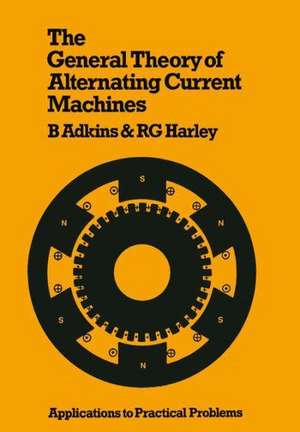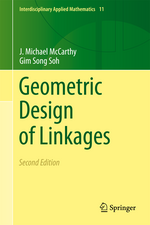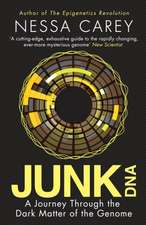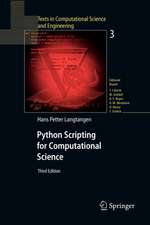The General Theory of Alternating Current Machines: Application to Practical Problems
Autor B. Adkinsen Limba Engleză Paperback – 23 feb 1978
Preț: 388.13 lei
Nou
Puncte Express: 582
Preț estimativ în valută:
74.29€ • 80.72$ • 62.45£
74.29€ • 80.72$ • 62.45£
Carte tipărită la comandă
Livrare economică 21 aprilie-05 mai
Preluare comenzi: 021 569.72.76
Specificații
ISBN-13: 9780412155604
ISBN-10: 0412155605
Pagini: 280
Ilustrații: XVI, 280 p.
Dimensiuni: 155 x 235 x 16 mm
Greutate: 0.42 kg
Ediția:1975
Editura: SPRINGER NETHERLANDS
Colecția Springer
Locul publicării:Dordrecht, Netherlands
ISBN-10: 0412155605
Pagini: 280
Ilustrații: XVI, 280 p.
Dimensiuni: 155 x 235 x 16 mm
Greutate: 0.42 kg
Ediția:1975
Editura: SPRINGER NETHERLANDS
Colecția Springer
Locul publicării:Dordrecht, Netherlands
Public țintă
ResearchCuprins
1 The Basis of the General Theory.- 1.1 The idealized machine.- 1.2 The two-winding transformer. Explanation of sign conventions and the per-unit system for electrical quantities.- 1.3 Magneto-motive force and flux in the rotating machine.- 1.4 Voltage and torque equations of the machine. The per-unit system for mechanical quantities.- 1.5 The fundamental assumptions. Saturation, harmonics, leakage.- 1.6 Calculation and measurement of parameters.- 2 The Primitive Machine.- 2.1 The equations of the cross-field commutator machine.- 2.2 Application to a simple d.c. machine.- 2.3 Equations for small changes and small oscillations.- 2.4 Sudden short-circuit of a d.c. generator.- 3 The Steady-State Phasor Diagrams of A.C. Machines.- 3.1 Representation of sinusoidal m.m.f. and flux waves by space phasors.- 3.2 The induction motor.- 3.3 The uniform air-gap synchronous machine.- 3.4 The salient-pole synchronous machine.- 3.5 Characteristic of a synchronous machine connected to an external supply.- 4 The General Equations of A.C. Machines.- 4.1 Equations in terms of phase variables.- 4.2 Transformation between various reference frames.- 4.3 Direct derivation of two-axis equations.- 4.4 Simplified equations of a synchronous machine with two damper coils.- 4.5 Equivalent circuits, operational impedances and frequency response loci.- 4.6 Summary of the equations for the synchronous machine with two damper coils.- 4.7 Modified equations with more accurate coupling between field and damper windings.- 4.8 General equations of the induction motor.- 5 Types of Problem and Methods of Solution and Computation.- 5.1 Classification of problems and methods of solution.- 5.2 Modified machine equations in terms of rotor angle ?.- 5.3 The state variable method and the state-space concept.- 5.4Calculation of system response and stability.- 5.5 Optimization. Performance indices.- 5.6 Computational techniques for transient studies.- 6 Automatic Control of Synchronous Machines.- 6.1 General.- 6.2 Excitation control of a.c. generators.- 6.3 Quadrature field winding. The divided-winding-rotor generator.- 6.4 Speed governors.- 7 A.C. Operation of Synchronous Machines.- 7.1 Steady operation of the synchronous machine at synchronous speed.- 7.2 Starting of a synchronous motor.- 7.3 Negative-sequence reactance of a synchronous machine.- 7.4 Small changes relative to a steady state.- 7.5 Approximate methods for forced oscillations.- 7.6 Free oscillations. Steady-state stability.- 8 Synchronous Generator Short-Circuit and System Faults.- 8.1 Symmetrical short-circuit of an unloaded synchronous generator.- 8.2 The analysis of short-circuit oscillograms.- 8.3 Short-circuit of a loaded synchronous generator.- 8.4 Unsymmetrical short-circuit of a synchronous generator.- 8.5 System fault calculations.- 8.6 Sudden load changes.- 9 Synchronous Machine Problems Requiring Step-by-Step Computations.- 9.1 Transient stability.- 9.2 Swing curves of a synchronous generator connected to an infinite bus.- 9.3 Loss of synchronism of a synchronous generator. Effect on rectifier excitation systems.- 9.4 Optimization of control inputs.- 9.5 Techniques for a multi-machine system.- 10 Effects of Saturation and Eddy Currents on Machine Performance.- 10.1 General.- 10.2 Methods of allowing for saturation.- 10.3 Effect of eddy currents in the magnetic material.- 10.4 Effect of eddy currents in the rotor conductors.- 11 Induction Motor Problems.- 11.1 Application of equations in primary reference frame.- 11.2 Equations in secondary reference frame. Complex form of the equations.- 11.3 Short-circuit and fault currents due to induction motors.- 11.4 Transient stability calculations.- 12 Application to Less Common Types of Machine.- 12.1 Classification in relation to the theory.- 12.2 Application of two-axis theory.- 12.3 Application of the phase equations.- 13 Appendices.- 13.1 Representation of a.c. and transient quantities by complex numbers. The generalized phasor.- 13.2 Current and voltage transformations when power is invariant.- 13.3 Operational methods.- 13.4 The per-unit system.- References.











